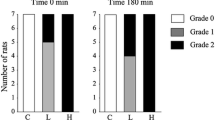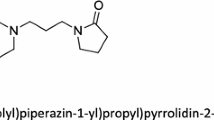Summary
The effect of β-adrenoceptor antagonists on the intravenous glucose tolerance test was investigated in conscious dogs. dl-Celiprolol (cardioselective with ISA=intrinsic sympathomimetic activity) 200 and 1000 μg/kg i.v., dl-metoprolol (cardio-selective without ISA) 200 and 1000 μg/kg i.v., dl-pindolol (non-selective with ISA) 5 and 25 μg i.v. and l-bupranolol (non-selective without ISA) 10 and 50 μg/kg i.v. were used in the study. The influence of β-adrenoceptor antagonists on the plasma glucose and immunoreactive insulin following the intravenous glucose tolerance test were evaluated by calculating the respective areas under the plasma curve.
The present investigtion clearly demonstrates the marked difference between the various β-adrenoceptor antagonists on heart rate and, especially on metabolic parameters. dl-Metoprolol, a β-adrenoceptor antagonist with cardioselectivity and without ISA can be assumed not to alter plasma insulin level and glucose assimilation. l-Bupranolol, a non-selective β-adrenoceptor antagonist without ISA reduces plasma insulin level and probably enhances peripheral glucose uptake, resulting in an “unchanged” glucose tolerance. dl-Celiprolol or dl-pindolol, β-adrenoceptor antagonists with ISA, but cardioselective or non-selective enhance both, basal insulin level and insulin level after glucose stimulation but must be assumed to decrease peripheral glucose uptake since here too glucose tolerance was unchanged.
Similar content being viewed by others
References
Åblad B, Carlsson E, Johnsson G, Regårdh CG (1980) In: Scriabine, pharmacology of antihypertensive drugs. Raven Press, New York, pp 247–258
Ahren B, Lundquist I (1981) Effects of selective and non-selective β-adrenergic agents on insulin secretion in vivo. Eur J Pharmacol 71:93–104
Bressler R, Vargas-Cordon M, Brendel K (1969) Inhibition of insulin secretion by aryl-substituted secondary aminoethanols. Diabetes 18:262–267
Cerasi E, Effendic S, Luft R (1969) Role of adrenergic receptors in glucose-induced insulin secretion in man. Lancet II:301–302
Church DB (1980) A comparison of intravenous and oral glucose tolerance tests in the dog. Res Vet Sci 29:353–359
Day JL (1975) The metabolic consequences of adrenergic blockade: a review. Metabolism 24:987–996
Dole VP, Meinertz H (1960) Microdetermination of long-chain fatty acids in plasma and tissues. J Biol Chem 235:2595–2599
Ekberg G, Hansson BG (1977) Glucose tolerance and insulin release in hypertensive patients treated with the cardioselective β-receptor blocking agent metoprolol. Acta Med Scand 202:393–397
Falloona GR, Unger RH (1974) Radioimmunoassay of glucagon. In: Jaffe BM, Behrmann HR (eds) Methods of hormone radioimmunoassay. Academic Press, New York London
Furman BL, Tayo FM (1974) Effect of some β-adrenoceptor blocking drugs on insulin secretion in the rat. J Pharm Pharmacol 26:512–517
Garrett BN, Raskin P, Kaplan NM (1980) Metoprolol in diabetes mellitus: effect on glucose homeostasis. Clin Sci 59:469–472
Harms HH, Spoelstra AJ (1978) Cardiac and bronchial β-adrenoceptor blocking potencies of atenolol, metoprolol, acebutolol, practolol, propranolol and pindolol in the anaesthetized dog. Clin Exper Pharmacol Physiol 5:53–59
Holm G, Johansson S, Vedin A, Wilhelmsson C, Smith U (1980) The effect of beta-blockade on glucose tolerance and insulin release in adult diabetes. Acta Med Scand 208:187–191
Imura H, Kato, Y, Ikeda M, Morimoto M, Yamata M (1971) Effect of adrenergic-blocking or-stimulating agents on plasma growth hormone, immunoreactive insulin, and blood free fatty acid levels in man. J Clin Invest 50:1069–1079
Iversen J (1971) Adrenergic receptors and the secretion of glucagon and insulin from the isolated, perfused canine pancreas. J Clin Invest 52:2102–2116
Kaneto A, Miki E, Kosaka K (1975) Effect of beta1 and beta2 adrenoreceptor stimulants infused intrapancreatically on glucagon and insulin secretion. Endocrinology 97:1166–1173
Lands AM, Arnold A, McAnliff DP, Luduena FP, Brown TG (1967) Differentiations of receptor systems activated by sympathomimetic amines. Nature 214:597–598
Loubatières A, Mariani MM, Sorel G, Savi L (1971) The action of β-adrenergic blocking and stimulating agents on insulin secretion. Characterization of the type of β receptor. Diabetologia 7:127–132
Majid PA, Saxton C, Dykes JRW, Galvin MC, Taylor SH (1970) Autonomic control of insulin secretion and the treatment of heart failure. Br Med J 4:328–334
Malaisse W, Malaisse-Lagae F, Wright PH, Ashmore J (1967) Effects of adrenergic and cholinergic agents upon insulin secretion in vitro. Endocrinology 80:975–978
Nakaki T, Nakadate T, Ishii K, Kato R (1981) Postsynaptic alpha-2 adrenergic receptors in isolated rat islets of Langerhans: inhibition of insulin release and cyclic 3′:5′-adenosine monophosphate accumulation. J Pharmacol Exp Ther 216:607–612
Pendelton RG, Petta JM, Hahn RA (1970) Studies on the myocardial depressant effects of KL 255: a β-adrenergic receptor antagonist. Arch Int Pharmacodyn 187:75–87
Pittner H (1981) Pharmacodynamic actions of celiprolol, a cardioselective beta-adrenergic blocking agent. Arzneim Forsch (in press)
Porte D, Jr, Smith PH, Ensinck JW (1976) Neurohumoral regulation of the pancreatic islet A and B cells. Metabolism 25:1453–1456
Rizza RA, Cryer PE, Haymond MW, Gerich JE (1980) Adrenergic mechanisms of catecholamine action on glucose homeostasis in man. Metabolism 29:1155–1163
Robertson RP, Porte D, Seattle MD (1973) Adrenergic modulation of basal insulin secretion in man. Diabetes 22:1–8
Sacca L, Eigler N, Cryer PE, Sherwin RS (1979) Insulin antagonistic effects of epinephrine and glucagon in the dog. Am J Physiol 237: E487-E492
Sirek OV, Vigas M, Niki A, Niki H, Sirek A (1969) Beta-adrenergic stimulation and insulin release in dogs following HB 419. Diabetologia 5:207–210
Waal-Manning HJ (1976) Metabolic effects of β-adrenoceptor blockers. Drugs 11:121–126
Author information
Authors and Affiliations
Rights and permissions
About this article
Cite this article
Conca, W., Beck, A., Bacher, S. et al. Plasma insulin levels and β-adrenoceptor antagonists. Naunyn-Schmiedeberg's Arch. Pharmacol. 320, 63–66 (1982). https://doi.org/10.1007/BF00499074
Received:
Accepted:
Issue Date:
DOI: https://doi.org/10.1007/BF00499074




